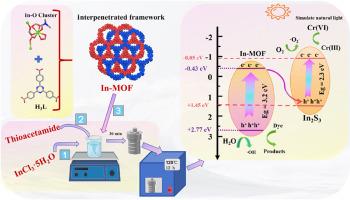Highly efficient and dual-functional photochemical elimination of Cr2O72− and reactive dyes via fabrication of a novel S-scheme binary heterojunction In2S3/In-MOF
IF 3.5
3区 化学
Q2 CHEMISTRY, INORGANIC & NUCLEAR
引用次数: 0
Abstract
Photocatalytic elimination of highly toxic Cr2O72− and stubborn reactive dyes requires photocatalysts to exhibit both robust oxidation and reduction capabilities. However, most single MOFs must utilize ultraviolet light and are incapable of concurrently providing sufficiently negative LUCO and positive HUCO potentials. In the current contribution, a water-stable In-MOF featured by typical n-type semiconductor was assembled and subsequently integrated with the in-situ growth In2S3 to construct a novel In2S3/In-MOF binary heterojunction. Notably, the intrinsic LUCO (−0.43 eV, vs. NHE) and HOCO (2.77 eV, vs. NHE) energy levels of deployed In-MOF exhibit a suitable band dislocation with In2S3's CB (−0.85 eV, vs. NHE) and VB (1.43 eV, vs. NHE) potentials. And this integration facilitates the establishment of an S-Scheme carrier transfer mechanism, effectively inhibiting carriers recombination and ensuring the efficient utilization of the robust redox abilities offered by In2S3's CB and In-MOF's HOCO. Under the driven of a low-energy xenon lamp, In2S3/In-MOF's optical-electrical properties involving photosensitiveness, photocurrent intensity and interface resistance have been notably improved. M55, with a feed mass ratio of In-MOF to In2S3 at 5 : 5, achieved a 99.9 % reduction efficiency for Cr(VI) within 80 min, degradation efficiencies of 77 % and 82 % for reactive dyes RB21 and RR2 within 12 h, respectively. Its reaction kinetics have increased by 8.79, 17.82 and 14.55 times compared to the pristine In-MOF, and by 1.66, 4.60 and 17.57 times relative to pure In2S3. This contribution offers a viable avenue for designing novel MOFs-based photocatalysts, which possess robust reducing and oxidizing capabilities, to address some intractable water pollution issues.

利用新型S-scheme二元异质结In2S3/In-MOF制备高效双功能光化学去除Cr2O72−和活性染料
光催化去除高毒性的Cr2O72 -和顽固的活性染料需要光催化剂表现出强大的氧化和还原能力。然而,大多数单一mof必须利用紫外光,不能同时提供足够的负LUCO和正HUCO电位。在本论文中,我们组装了一个具有典型n型半导体特征的水稳定In- mof,并随后与原位生长的In2S3集成,构建了一个新的In2S3/In- mof二元异质结。值得注意的是,所部署的In-MOF的本征LUCO (- 0.43 eV,相对于NHE)和HOCO (2.77 eV,相对于NHE)能级与In2S3的CB (- 0.85 eV,相对于NHE)和VB (1.43 eV,相对于NHE)能级表现出合适的能带位错。这种整合促进了S-Scheme载流子转移机制的建立,有效地抑制了载流子的重组,并确保了In2S3的CB和In-MOF的HOCO所提供的强大氧化还原能力的有效利用。在低能量氙灯的驱动下,In2S3/In-MOF的光敏性、光电流强度和界面电阻等光电性能得到了显著提高。当In-MOF与In2S3的进料质量比为5:5时,M55在80 min内对Cr(VI)的降解效率达到99.9%,对活性染料RB21和RR2的降解效率在12 h内分别达到77%和82%。其反应动力学分别比原始In-MOF提高了8.79、17.82和14.55倍,比纯In2S3提高了1.66、4.60和17.57倍。这一贡献为设计新型mofs光催化剂提供了一条可行的途径,该催化剂具有强大的还原和氧化能力,可以解决一些棘手的水污染问题。
本文章由计算机程序翻译,如有差异,请以英文原文为准。
求助全文
约1分钟内获得全文
求助全文
来源期刊

Journal of Solid State Chemistry
化学-无机化学与核化学
CiteScore
6.00
自引率
9.10%
发文量
848
审稿时长
25 days
期刊介绍:
Covering major developments in the field of solid state chemistry and related areas such as ceramics and amorphous materials, the Journal of Solid State Chemistry features studies of chemical, structural, thermodynamic, electronic, magnetic, and optical properties and processes in solids.
 求助内容:
求助内容: 应助结果提醒方式:
应助结果提醒方式:


